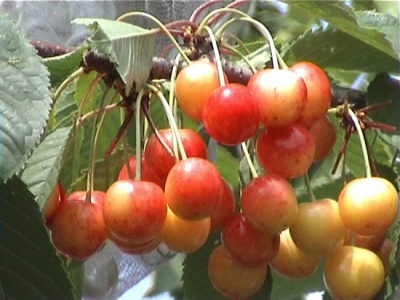
- Pruning: necessary
- Fruit shape: heart-shaped
- Authors: Belarusian selection
- Appeared when crossing: Red dense x (Valery Chkalov + Ugolyok)
- Growth type: medium-sized
- Appointment: universal
- Yield: high
- Crown: pyramidal, raised, medium density
- Fruit size: large
- Fruit weight, g: 6,8
Cherry of the Rival variety, aka Bird cherry, has gained recognition among gardeners due to its taste, fertility and other parameters. With proper care, the tree is able to calmly survive frosts and resist diseases. Nowadays, sweet cherry has many varieties and is widespread throughout most of Russia.
Breeding history
The rival as a hybrid variety appeared in 1983 in Belarus at the Institute of Fruit Growing. Breeders used Russian varieties of cherries Krasnaya Densenaya, Valery Chkalov (pollinator) and one Ukrainian Ugolyok (pollinator). In 2001, the variety was recognized as elite, and after 7 years it was transferred to the network of the State variety testing.
Description of the variety
The tree is medium-sized, has a pyramidal crown with a moderate number of leaves. The variety has a universal purpose.
Fruit characteristics
Yellow, with pink and red blotches, by the degree of ripening, fully or partially reach a bright light red hue. The peel and flesh of the berries are dense, average weight: 6.8 g. The shape of the fruits themselves: heart-shaped. They are large.
Taste qualities
The rival's fruits are juicy, sweet, practically not sour, with colorless juice. Fruit tasting score - 4.8 points.
Ripening and fruiting
The process usually takes place in the second half of the summer. Fruiting itself begins at 4 years of age. Ripening period: average.

Yield
The variety is characterized by a high yield level. Maximum: 32 t / ha.
Growing regions
It is more often found in the central part of Russia, in the Moscow region, but it acclimatizes well in the middle lane and other, more northern regions.
Self-fertility and the need for pollinators
The plant is self-fertile. Of pollinators, the following are well suited: Iput, Yantarnaya, Gostinets, Gronkavaya, Syubarovskaya.
Growing and care
The variety prefers sunny areas, with sandy loam, well-fertilized soil. When planting seedlings, a depression is made in the ground with a diameter of 0.5-0.6 meters. Humus or other non-nitrogen fertilizers can be added before instillation. After planting the seedling, the ground around it is tamped and watered abundantly (1-2 buckets). It will not be superfluous to use a support.
If you are planting two or more trees, the distance between them should be at least 3 meters. The first few months must loosen the soil - this provides oxygen access to the fragile root system. Summer cultivation is recommended to be done superficially.
It is important to prune young trees correctly, removing unnecessary and deeper branches.They also need timely prevention of diseases and pest attacks. In other aspects, the variety is quite unpretentious. The Opponent absorbs urea well from nutrient solutions. For 600 g, 10 liters of water are taken, spraying is done in the evening.




Disease and pest resistance
Trees are well resistant to coccomycosis fungus. However, young and immature are prone to verticillosis. Until the leaves appear, the culture is treated with a solution of the fungicide Kuproksat. Bordeaux 3% liquid is considered a universal remedy in the fight against fungus. Newly formed leaves are also treated with solutions, as well as in the periods before and after flowering, at the end of summer and in October.
For more serious cases, use means: "Fundazol", "Polychrome", "Polycarbacin".

Requirements for soil and climatic conditions
Experienced gardeners can judge the suitability of the soil at one time or another by the state of the leaves: they can turn yellow or fall off. The most common reasons include either a lack of fertilizer or oxygen. In the second case, it is recommended to water the ground with a weak solution of potassium permanganate.
































































